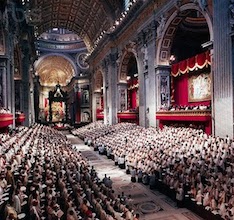Just a few weeks ago, we celebrated the 50th anniversary of the opening of the Second Vatican Council. Accordingly, there has been a good deal of commentary from historians, theologians and even from the handful of bishops and experts who actually participated in the Council five decades ago. I was particularly struck by an observation made by Fr. John O’Malley, the Jesuit historian who penned, some years ago, an influential book called What Happened at Vatican II? The Second Vatican Council, he said, was the largest meeting in the history of the world. Indeed, some 2,600 people—bishops, theologians, observers and advisors—gathered for months-long sessions between 1962 and 1965; they were setting agendas, debating, arguing, voting and resolving. In a word, they did all the things that people typically do at business meetings.
I will confess that O’Malley’s insight produced quite an “a-ha!” moment in me. I came of age in the years just following Vatican II. I went to first grade in 1965, the year the Council ended, and my Catholic formation and seminary training all took place from the early ‘70s to the mid-‘80s of the last century. This means that I was thoroughly immersed in a “Vatican II” culture. Now, one of the marks of that period of ecclesiastical history (and this is why O’Malley’s remark was so illuminating to me) was a preoccupation, even an obsession, with meetings. At the diocesan level, at the parish level, at seminaries, in regard to schools and hospitals, etc., Catholics met. As many have observed, bureaucracies burgeoned everywhere in the Church after Vatican II, and what are bureaucracies but structures established to facilitate meetings? When I was a seminarian, I was invited by the leaders of my home parish to get a taste of parish life. Did they send me to a soup kitchen, or into the school, or to the sacristy, or on a communion call? No, they asked me to take the minutes at a meeting of the parish staff! O’Malley helped me to see that, for the generation of church people that formed me, the defining event of their lives was indeed a giant meeting, and hence the meeting became for them something of almost sacred importance.
Now don’t get me wrong, I completely understand the importance, even necessity, of meetings. From time to time, every group or organization has to pause, gather, assess and discuss its work. Otherwise, it will not adequately fulfill its mission or purpose. A meeting is the matrix for this process, and hence the virtues of a meeting include open-mindedness, mutual respect, and honest dialogue. But a meeting is never an end in itself. Its purpose is to clarify mission and strategy so as to enable the members of an organization to return to their work with renewed vigor and focus. The open-mindedness and dialogue, which are indeed prime virtues of a meeting, are not necessarily the virtues attendant upon action. Would you expect the passionate sales representative for the Ford Motor Company to be open to discussing the value of Toyota’s latest model with his customer? Would you expect a Catholic evangelist to be in an attitude of wondering whether Christianity is really the best religion?
In an article explaining why he had quit the editorial board of the journal Communio, whose stated purpose was the perpetuation of the spirit of Vatican II, Joseph Ratzinger said that it is not in the best interest of the Church to perpetuate the spirit of any council. Only 20 times in its 2,000-year history, Ratzinger wrote, has the Catholic Church held a council—and thereupon hangs a tale. Indeed, there have been key moments when the Church had to pause and interrogate itself in regard to some basic matters of belief and practice. At the Council of Jerusalem in the first century, for example, the nascent Christian community had to decide whether and how non-Jews could become followers of Jesus; at the Council of Nicea in the fourth century, the Church had to determine, with some precision, just who Jesus is; at the Council of Trent in the 16th century, the Church had to formulate a response to the powerful challenge offered by the Protestant reformers, etc. Those “meetings,” those gatherings during which the Church paused, threw itself into question, and came to crucial determinations, were necessary. But it was, with a certain sigh of relief, that the Catholic community turned from those moments, for it was eager to get back to its basic work and form of life. Listening, dialoguing, wondering, doubting and discussing were all appropriate during a conciliar meeting, but those activities were not necessarily helpful in the actual accomplishment of the Church’s mission of declaring the Lordship of Jesus.
I think it is plausible to argue that the Vatican II generation was beguiled by the ethos and style of the greatest meeting in human history. And this goes a long way toward explaining why that generation was compromised in its capacity to evangelize with confidence.
